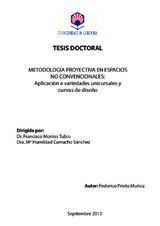Metodología proyectiva en espacios no convencionales: Aplicación a variedades unicursales y curvas de diseño
Autor
Prieto Muñoz, Federico
Director/es
Montes Tubío, Francisco de PaulaCamacho Sánchez, Mª Humildad
Editor
Universidad de Córdoba, Servicio de PublicacionesFecha
2014Materia
Espacios proyectivosEspacios no convencionales
Variedades unicursales
Curvas de diseño
Involución
Estrofoides
Deltoides
METS:
Mostrar el registro METSPREMIS:
Mostrar el registro PREMISMetadatos
Mostrar el registro completo del ítemResumen
The first chapter is devoted to set out the working plan; it justifies the content and outlines
novel and applied aspects of this work.
Chapter II includes the basic concepts behind the entire dissertation. The abstract concept
of projective space is briefly recalled here and all those spaces considered as conventional
spaces that have been widely analyzed by classical authors are also mentioned in this
chapter.
Below, some of them whose study had scarcely been approached by the structuralist
principles of the Algebra have been listed within the graphical environment.
This chapter ends with the introduction of what we consider is a new concept. We are
speaking of spaces of bipoints, birays, tripoints, etc. Those spaces will greatly assist us in
deducing certain graphical properties.
Chapter III is entirely devoted to the generalization, in all its forms, of the concept of
involution, there we establish results as curious as the fact that the involutions of the points
of a line are the lines of the two-dimensional space of bipoints contained in it.
Once the foundations of the work are established, we move into the Chapter IV to develop
the main concept of this dissertation: unicursal varieties.
The general concept of unicursal variety is defined at that point, and then we focus
immediately on the explanation of the very unicursal varieties.
We pushed aside a huge number of useful spaces such as ruled surfaces with unicursal
cuspidal edge, polar surfaces of unicursal curves, twisted cubics, unicursal twisted quartics,
etc. Any of these topics duly developed could be the subject of a new thesis.
In this chapter a general theorem about involutions is discussed, it widespread generalize
theorems as classic as the Descargues’theorem applied to families of conics.
Some examples of certain complexity are shown in this chapter, where the power of
the theorem can be appreciated for deducing complex graphical properties through scant
calculations. At some stage, we resort to use symbolic computation in order to save some
tedious steps...

